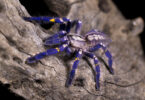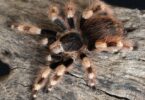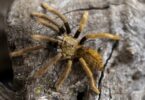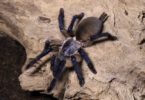Are you curious about the Cyriopagopus lividus (ex. Haplopelma lividum), commonly known as the Cobalt Blue Tarantula? This species is native to tropical rainforests in Thailand and Burma (Myanmar). In this blog post, we will look at the appearance, venom and temperament of this beautiful yet formidable creature.
We will also provide a comprehensive housing guide for aspiring tarantula owners who would like to keep these feisty spiders as exotic pets. Get ready to discover all there is to know about one of nature’s most gorgeous Old World fossorial tarantulas!
Appearance and Size of the Cobalt Blue Tarantula
The Cobalt Blue Tarantula is a species of tarantula that is characterized by its striking color variations which range from light blues, to greens and purples. This visually stunning spider has an adult leg span measuring between 6-7 inches and a body size of approximately 3 inches in length.
While males are smaller than females, it’s the mature females which showcase their most impressive cobalt blue coloring. Its other physical characteristics include stiff bristles known as setae on each of its eight legs as well as defining tufts of hairs (termed scopulae) running along the back half of each jointed appendage.
Due to these remarkable features, many tarantula enthusiasts around the world have been attracted to keeping Cyriopagopus lividus has a pet due to its vibrant colors and striking appearance.
Venom and Temperament of the Cobalt Blue Tarantula
Cobalt blue tarantulas are known for their powerful venom, which is why caution should be taken when handling them. Their venom has a low toxicity level to humans; however, it’s still extremely painful and can cause an intense wound that often requires medical attention.
Additionally, the cobalt blue tarantula is one of the most aggressive species in its family, capable of inflicting a very painful sting through their potent venom if disturbed or provoked.
Because of this aggression displayed towards potential threats or perceived dangers, dealing with them requires extra care and attention as they can unexpectedly bite at any time. When keeping Cyriopagopus lividus as pets it is important to always handle them carefully and ensure not to disturb their habitats too much.
This will help ensure that interactions with these spiders remain free from danger and pain!
Housing Guide for Cyriopagopus lividus
• The popular enclosure for adult Cyriopagopus lividus is typically 11×11 inches (30x30x30 cm) in size and can be filled with a thick layer of coconut fiber. Because these spiders typically burrow, the substrate is more than enough to serve as their hide. However, attempting to mimic their natural habitats with an excessive amount of soil will result in a less appealing view of the spider and will lead to mold due to the high humidity (around 80% and temperature ~80°F) required. It is better to use a smaller amount of substrate and incorporate a root or cork pieces around which the spider will create a network of tunnels using a significant amount of web.
This will also provide an interesting opportunity for observation as the spider transports peat from one place to another. In this way, we deceive and minimize the secretive lifestyle of this species, giving ourselves as many opportunities as possible for observation.
Breeding of the Cobalt Blue Tarantula
• Breeding Cyriopagopus species can be tricky because the females usually mess up or don’t even make an egg sac. Also, the enclosure can get too humid plus leftover food residues often left by the female in her burrow can lead to mite development. My suggestion of building the terrarium with a smaller layer of coconut fiber may work well. If the egg sac is successful, there can be about 100 eggs in it. Females reach sexual maturity at a body length of 6 centimeters.
Conclusion
The Cyriopagopus lividus, also known as the Cobalt Blue Tarantula, is a stunning arachnid native to tropical Southeast Asia that makes an exciting and captivating exotic pet for experienced keepers.
This species has impressive iridescent cobalt-colored legs combined with a light gray prosoma and underground burrowing habits. Its defensive nature and fast growth rate make it unsuitable for beginners or inexperienced owners.
It is essential to provide its burrowed habitat in captivity with plenty of food sources to ensure its well being. With the correct care and caution this tarantula can repsent an incredible addition to any hobbyist’s collection of unique spider species!
FAQs
1. How long does cobalt blue tarantulas live?
Cyriopagopus lividus (ex. Haplopelma lividum) can live up to 15 years.
2. What does cobalt blue tarantula eats?
Cyriopagopus lividus, like any other tarantula, feeds on insects such as Argentine roaches, crickets, or mealworms. Turkish roaches are excellent for younger individuals because they are constantly in motion, making them more likely to be found by our pet sooner or later.
3. Are Cobalt Blue Tarantulas dangerous or venomous?
Cobalt Blue Tarantulas are not generally considered dangerous to humans - however, it can attract very quick defensive bites that may cause pain, muscle cramp and swelling. It’s best to leave them untouched if you’re not sure how your body will react to its venom.






